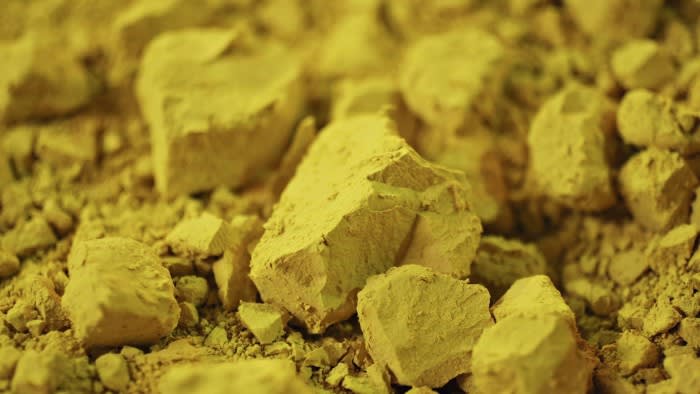Unlock the Editor’s Digest for free
Roula Khalaf, Editor of the FT, selects her favourite stories in this weekly newsletter.
Kazatomprom, the world’s largest uranium producer, has slashed its production target for 2025 due to project delays and sulphuric acid shortages, threatening to squeeze supplies of the radioactive fuel vital for nuclear power.
The Kazakh company, which generates a fifth of global uranium supply, cut its target for next year by 17 per cent to a range of 25,000 to 26,500 tonnes of yellowcake.
The move is likely to put upward pressure on uranium prices, which have softened from a 16-year high above $100 per lb this year but remain at historically elevated levels above $80 per lb, according to UxC, a pricing data provider.
Meirzhan Yussupov, chief executive of Kazatomprom, said that “the uncertainty around the sulphuric acid supplies for 2025 needs and delays in the construction works at the newly developed deposits resulted in a need to re-evaluate our 2025 plans”.
Nuclear power has undergone a revival since the world was plunged into an energy crisis by Russia’s full-scale invasion of Ukraine, but uranium supplies have struggled to keep up with the boost in demand following a decade of under-investment in new production.
“This is a structural problem — they cannot ramp up,” said Nick Lawson, chief executive of Ocean Wall, an investment house that is bullish on uranium. “It won’t just be the west saying this is an issue for us; it will also be Russia and China saying it’s a problem for our new nuclear power plants.”
Utilities hold large stockpiles of uranium to power their nuclear reactors but they are willing to secure the nuclear fuel at almost any price, creating the conditions for volatile surges in prices of yellowcake.
Per Jander, director of nuclear fuel at WMC, a trader, said that Kazatomprom’s downgrade “should be a cause for concern for western utilities. The geopolitical developments and writing on the wall has been the Russians getting closer to the Kazakhs.”
Analysts at Canaccord Genuity said that they expected Kazatomprom to produce 23,000 tonnes in 2025, adding that the bottom line was “market to be tight next year”.
They added the company placed the target higher “to stay in the government’s good graces” given that it must come close to output levels specified in subsoil use agreements signed with Astana.
Because of expectations that it will not produce above the 80 per cent threshold in the next two years for Budenovskoye, one of its new uranium mines, Kazatomprom asked the government to lower targeted output volumes in the agreement. At another site, it also asked for the agreement to be amended.
Despite forewarning in February on the risk of cuts to the output forecast, inventories at Kazatomprom are running at the lowest ever reported, according to Canaccord Genuity, at 4,142 tonnes of uranium, down 31 per cent on the previous year.
Sulphuric acid, essential to extracting uranium from deposits, has been in short supply in Kazakhstan because of delays in building new acid plants, competition with the fertiliser industry and trade restrictions.
Further stoking insecurity in the market has been Russia’s central role in the conversion and enrichment of raw uranium into nuclear fuel, controlling almost 50 per cent of global enrichment capacity.
Kazatomprom has recently been rocked by a spate of executive departures including its chief financial officer Sultan Temirbayev, who resigned this month after only a year in the post.


